As the curtain comes down on what is considered as a fascinating season of the MLS, it is also the time for teams to have a detailed look on what they have done best and what went wrong for their tactics and players. For Atlanta United, they entered this season being the defending champions and aimed to retain that number one spot once again. Still, under the management of Frank de Boer, a struggling start was something that hindered their progress on their journey to accomplish that expectation.
Things started to turn positive for them as a strong run in between April and June saw them return to the chase for the Eastern Conference trophy and a spot in the playoff’s semifinal. One of the factors that contributed to their U-turn in form was the solidity in their defence. With Leandro González Piréz remaining as the key player in defence and the experience of veteran centre-back Michael Parkhurst, Atlanta only conceded eight goals in thirteen matches during that period. But the player that really caught the eyes of Atlanta’s fans was Miles Robinson as he slowly built himself a place in de Boer’s 3-5-2 formation.
The Generation Adidas defender was picked during the 2017 Superdraft and was nurtured under “Tata” Martino after he returned from his loan spell at Charleston Battery. Since then, he became a backup choice for Atlanta and now played a key role in the team’s defence, considering he is only 22. Although an injury saw him miss out during the post-season period and prevented him from completing his first season as a starter, his performance did catch the eyes of many experts which led to him being selected in the MLS Team of the Year and nominated for the Defender of the Year award.
This tactical analysis scout report will provide an analysis of Miles Robinson’s standout 2019 season with Atlanta United. Meanwhile, using statistics and footage, we will also point out the strengths that he had shown during the season and the weaknesses that he needs to improve playing in the team’s tactics.
Overview and style of play
Originally, Robinson was the third-choice centre-back among Atlanta’s squad in the 2018 season, the season that saw them triumph the MLS Cup and at times he even turned into a fourth-choice with Franco Escobar also being able to move into the position. This season, with the addition of Florentin Pogba, many have thought that the American youngster would be sent out for a loan. But instead, he stepped into the position that captain Michael Parkhurst had occupied in the last two seasons and linked up with Leandro Gonzáléz Piréz at the heart of Atlanta’s defensive line.
During the first few matches, de Boer set his team up in a 4-2-3-1 formation, the formation which helped Martino and his players lift up the MLS Cup trophy in the 2018 season. In that formation, Robinson was used as a right-sided centre-back to maximise his ability when he uses his preferred foot. He and his centre-back partner would receive support from the two defensive midfielders up front who took on the responsibility of screening the space in front of the defence and intercepted passes that came towards them, similar to the lineup below against New York Red Bulls.
But this formation proved to be a disaster for Atlanta as it neutralised the ability of their attackers up front, such as Gonzalo “Pity” Martínez. In defence though, they also faced some problems related to their high defensive line. During their Concacaf Champions League match against Monterrey, the Georgia-based club was usually put on the back foot when their opponents created a counter-attack. In several occasions, there was space being created behind the team’s defensive line and Atlanta’s centre-back struggled in terms of catching up with the opposition’s attackers, allowing them to approach the 16-yard box more easily. Although they used a back-three for that match, the problem was also demonstrated during matches that they implemented a back-four.
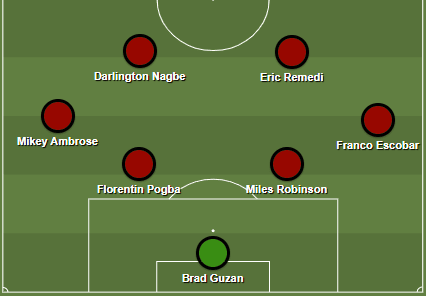
But since the Dutch manager switched the team’s formation into a 3-5-2, they also saw a U-turn in their fortune which later became a crucial part in the team’s overall third-place finish in the MLS. In the role of a ball-playing defender, he was often used slightly to the right when Parkhurst returned to the starting lineup. Also, playing in the central of the back-three was an option that was constantly seen this season in case de Boer wanted to use Escobar as a right-sided centre-back and allowed him to contribute more to the attack.
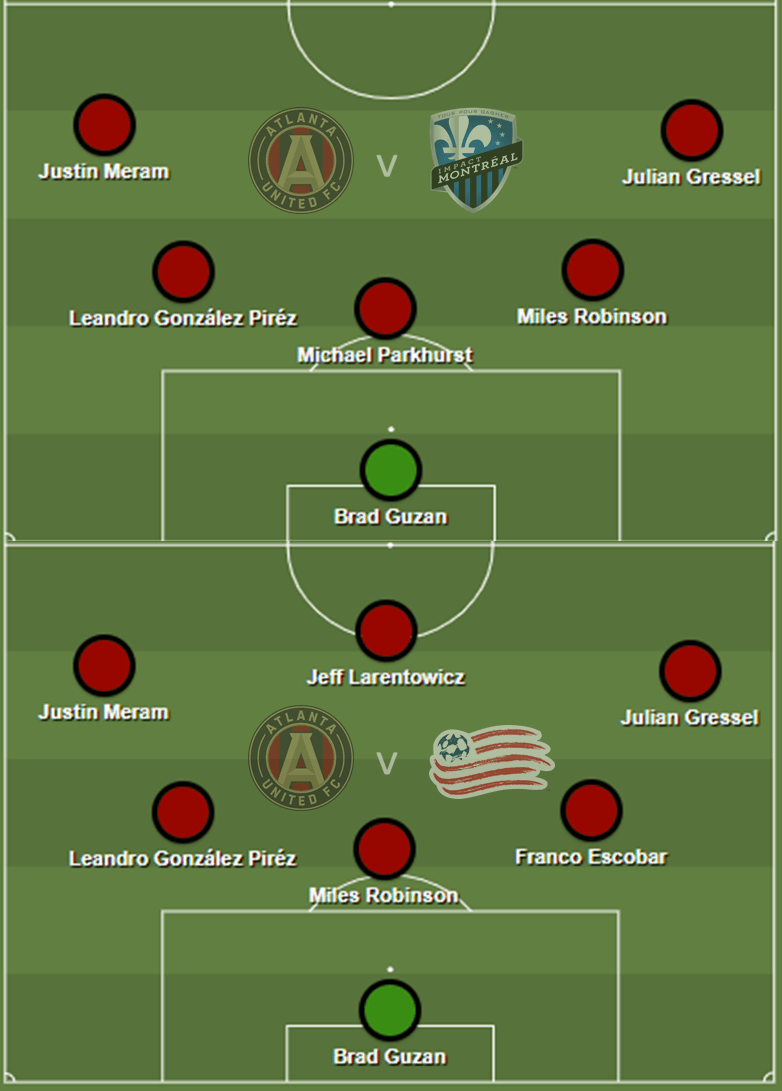
On the field, it is easy to notice that Robinson is somewhat a mix between González Piréz and Parkhurst as his style of play exposes both players’ traits. In the former River Plate defender, he finds himself as a more accomplished ball-playing defender who usually makes penetrative passes to start the team’s attack. No matter if it is a long-ranged or a short-ranged pass, González Piréz would manage to find its destination. Robinson is still developing his passing ability as he is less likely to make long passes compared to his colleague.
Meanwhile, in Parkhurst, he is more of a covering defender who would bring solidity to the defence and allow his teammates to move away from his position. At the same time, he also tended to be involved in duels by himself to help the team recover possession. But as age is catching up with him, the pace becomes a big obstacle for him as the former Columbus Crew defender would find himself being bypassed easily by the opposition’s attackers occasionally. With him announcing his retirement as the season came to an end, many expected Robinson to step into his boots and become a key player for Atlanta.
This season, Robinson also played in the role of a covering defender on several occasions and he is the reason behind the return of the high press among Atlanta’s tactics. As we will dig deeper into why the high press was made possible when Robinson played, it is worth looking at Parkhurst and Robinson’s stats from Smarterscout below to understand if he can become Parkhurst’s successor or not.
Notice the captain’s disrupt and recover stats, which stands at 46% and 50% respectively and they are at an average rate compared to the benchmark of a Premier League defender. For Robinson, the numbers are higher as it reaches 73% and 63% respectively and it shows a big improvement compared to the veteran defender himself.
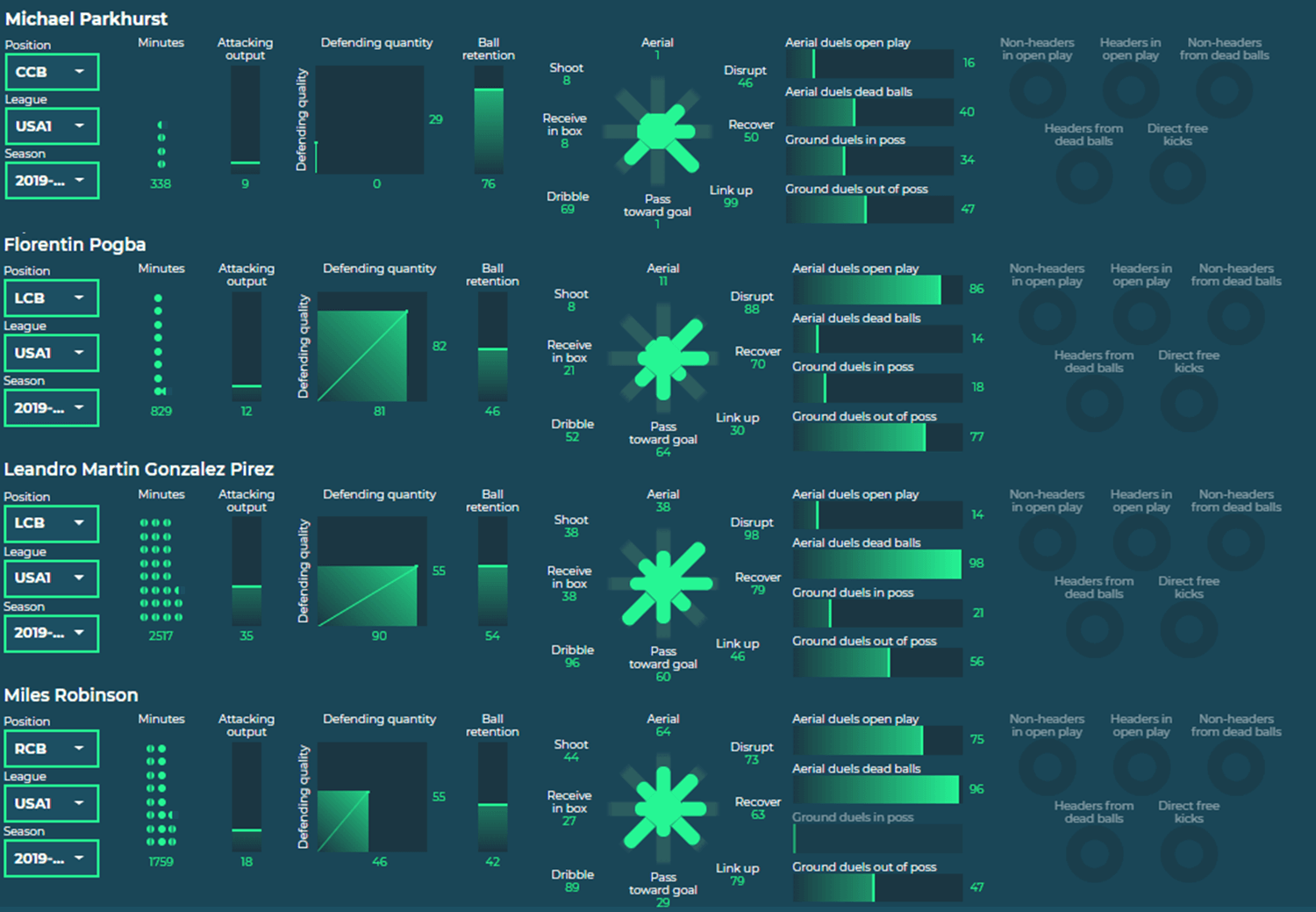
Defensive abilities
When Atlanta were not on possession, their 3-5-1-1 formation usually retreated into a 5-3-2. Their aim was to defend zone 14 and prevent short combinations between the opposition’s players. Three central midfielders were given the license to shift flexibly along with the ball as they have to screen the defence and create overloads along with them.
Meanwhile, the defensive line stretched a bit wide and filled in the area in front of their 16-yard box. In case a player dropped out to mark the ball carrier, his teammates would move centrally and create a back-four. It’s easy to understand why de Boer went for this tactics, as his defensive juggernaut proved to be quite efficient over the course of the season.
At the same time, the Dutch managed also wanted his players to maintain the press even when the opposition had the ball inside the middle third. In order to do so, the defensive line must push higher to provide support for the players up front and also caught the attackers who intended to attack the space behind them through the offside trap. With a system that required a high level of discipline, a slight movement with the aim of closing the opposition’s ball carrier down could create space behind Atlanta’s defenders back and invite the attackers to enter.
In the situation below, Escobar and Gressel decided to move higher to close down Columbus’ ball carrier and attempt to nick the ball away from him. Unfortunately, they left a huge gap behind their back and Gyasi Zardes was on hand to notice that. As the American international entered the unoccupied gap to receive the pass, he faced the pressure from Robinson who intended to close that area down and already pick out Zardes’ intention. Using his physicality, he was able to shield Zardes’ movement and prevent him from utilising his pace to pick up the ball and continue Columbus’ attack.
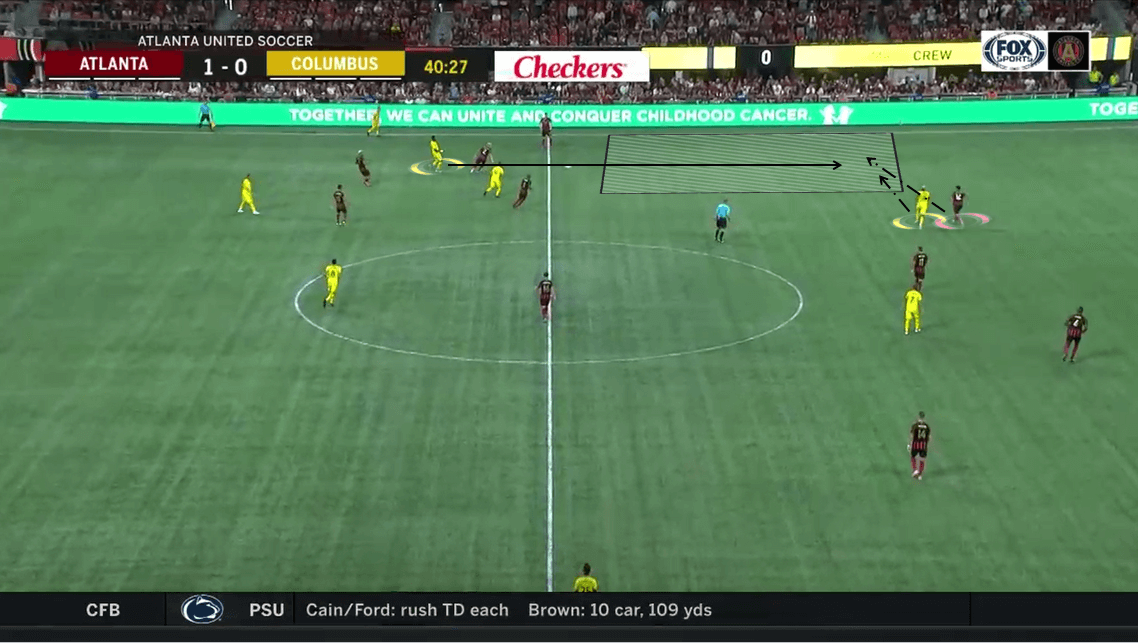
There are reasons behind the compliments that come from his teammates about how good he is in terms of involving in duels. Firstly, he exposes a great open-field speed which allows him to catch up with pacey attackers, similar to Zardes in the situation above. In fact, in the same match against Columbus, there were several occasions in which the former LA Galaxy player had the ball and attempted to sprint towards Atlanta’s 16-yard box. But Robinson managed to track his run and made the most out of his pace to catch up with Zardes and stopped him from executing his intention.
Secondly, the desire of recovering possession for the team. Usually, this trait will come along with the fact that a defender has to be aggressive in order to win the ball back. Robinson isn’t that type of player, though, as he tends not to dive into tackles often. But when he does, those tackles would play a crucial role which helped Atlanta players receive the ball back or even save them from a goal. His decision-making is the ability that allowed him to know when is the perfect time to slide in without committing a foul for the team, therefore, avoiding dangerous free-kicks around the box and penalties while still able to prevent the opposition from reaching Brad Guzan’s goal.
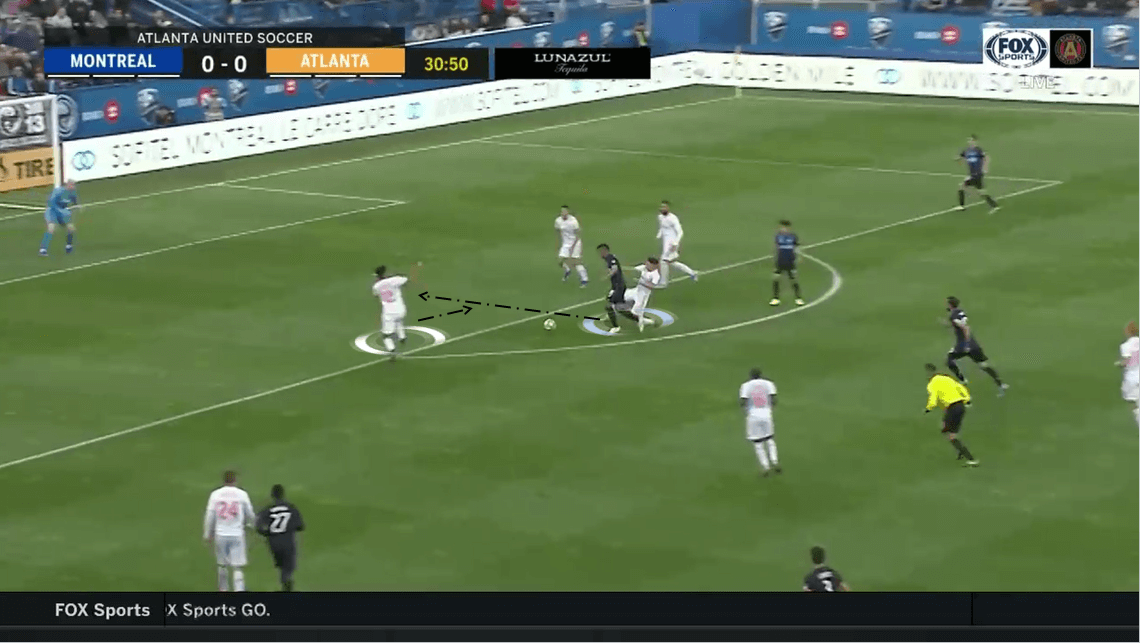
Thirdly, his off-the-ball intelligence provided him with a big advantage as he can anticipate the intent of the opposition’s ball carrier and make that one step earlier than the ball carrier. In most duels, the opposition’s attacker tended to find himself on the back foot when he attempted to bypass Robinson. Because of the fact that the American youngster already identified what that attacker would do and what he should do, it made the situation easier for Robinson to shield the ball away and recover possession for his team.
Furthermore, as mentioned above, when Atlanta tended to play with a high defensive line, the opposition would also be able to create counter-attacks on a more constant basis. This put the defenders in more duels during the transitioning process, especially 2 v 1 duels similar to the situation from their match against Montreal below. Usually, the attention of a defender would be put on the ball carrier and this allowed one of the attackers to move into their blindside and receive the ball there.
For Robinson, though, he tends to scan his shoulder to check if there are any players moving behind and around him. If there are, the American centre-back would keep a sufficient distance with the ball carrier while still be able to keep the attacker behind him in control by continuing to retreat towards the 16-yard box. When a pass was made, there would be space and time for him to either shield it away from the attacker or intercept it and launch an attack. If there aren’t then he’s involved directly in a 1 v 1 duel as his choice since he can use his physicality and anticipation to predict where will the ball go next and stop the ball carrier from executing it.
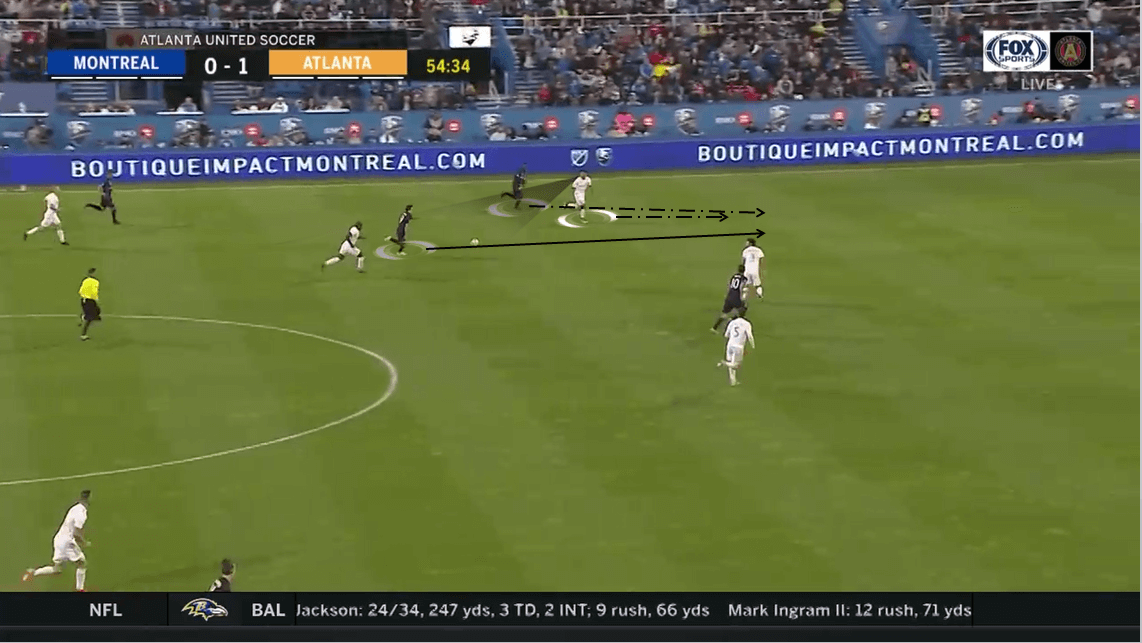
As good as Robinson is in using his standout attributes to be involved in duels, he also makes the most out of it when he marks the opposition’s attackers. As mentioned, the Atlanta centre-back tends to keep a sufficient distance with either the ball carrier or the player that he is marking. This allows him to have space to close that player down in case he receives the pass and tackle it away from him. With 7.27 defensive duels involved per 90 minutes and winning 69.5% of them, it is clear to see how good he was in terms of maximising his pace and vision to help him identify the ball’s direction and directly be involved in duels to recover possession for Atlanta.
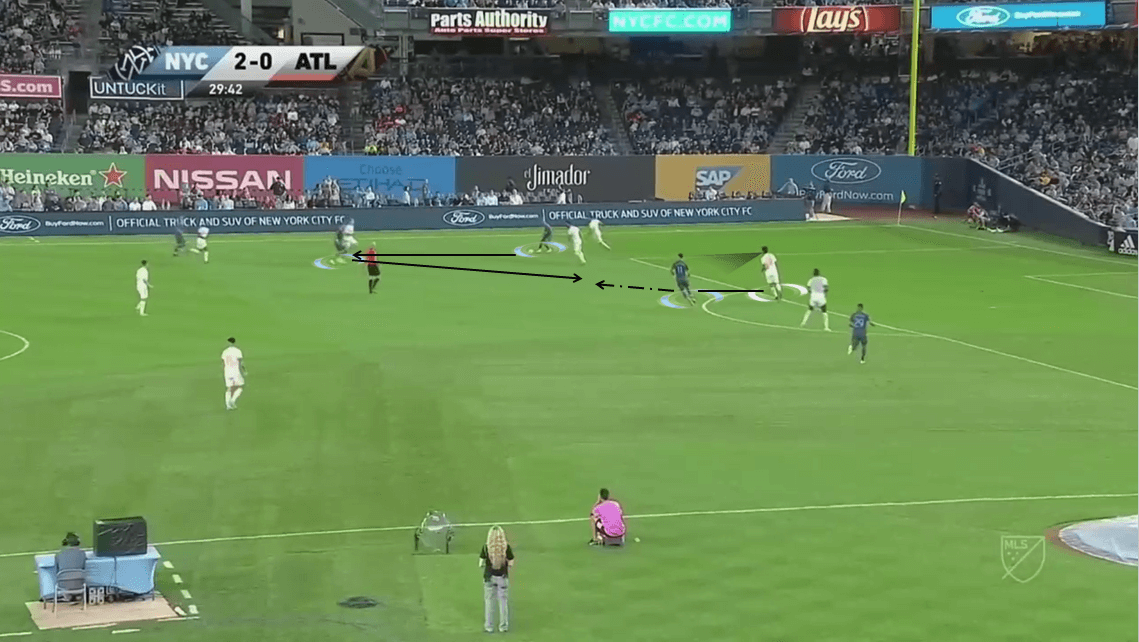
Last season, one of Robinson’s attributes that can be seen as having improved the most is his positioning. Rather than being rushed in following the attacker’s run, he tended to be composed in picking out a position in the direction of the ball and then stick his foot into. Again, similar to how his trait of not diving into tackles more often, this helped him to commit fouls on fewer occasions and therefore, conceded few unnecessary free-kicks inside the team’s defensive third. The numbers also demonstrate this as he only committed 0.65 fouls per 90 minutes and received a total of four yellow cards over the course of last season.
Furthermore, his positioning also benefits him in aerial duels as it combines with his physicality to gain him an advantage when winning the ball back in the air. In the situation below against Montreal Impact, he was put in a more negative state as there was an attacker behind his back ready to receive the ball from his teammate. Still, as he didn’t turn his body towards the attacker, he oriented his body towards the ball carrier while still keeping the player behind him in control. It helped him to pick out where the ball dropped and intercept the pass, allowing the team to have a turnover and create a counter-attack. On average, he registered 4.26 aerial duels and managed to complete 63.8% of them – the highest number among Atlanta’s four centre-backs.
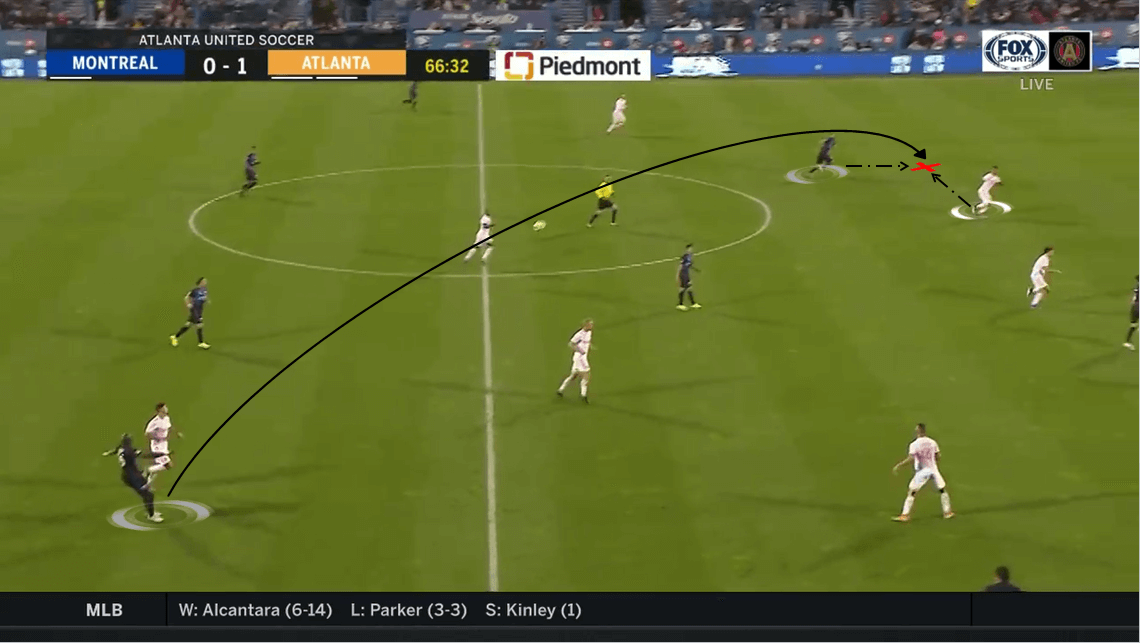
But as good as his positioning is, there were some occasions that his positioning came back to haunt him and even the team. As demonstrated in the situation below, a cross was sent in the box by a Columbus player in an attempt to find the player who was approaching the 6-yard box. Robinson had the head start compared to Luis Argudo and eventually did manage to reach the ball.
His positioning was great in order to pick out the direction of the ball and recover it before the Columbus player could reach it. Still, his intention of making a clearance went the wrong way as he used his right foot to hit the ball, only then to find it had little force to go over the goal and Guzan wasn’t able to save the own goal. In terms of his stats, with 7.69 losses per 90 minutes and 55.1% of them occurred inside Atlanta’s half, they are somewhat concerning numbers as it decreasing his defending quality. But at the age of 22, he still has more to learn and develop, in which he can improve the number of losses to help the team by preventing counter-attacks being created inside their half or near the 16-yard box.
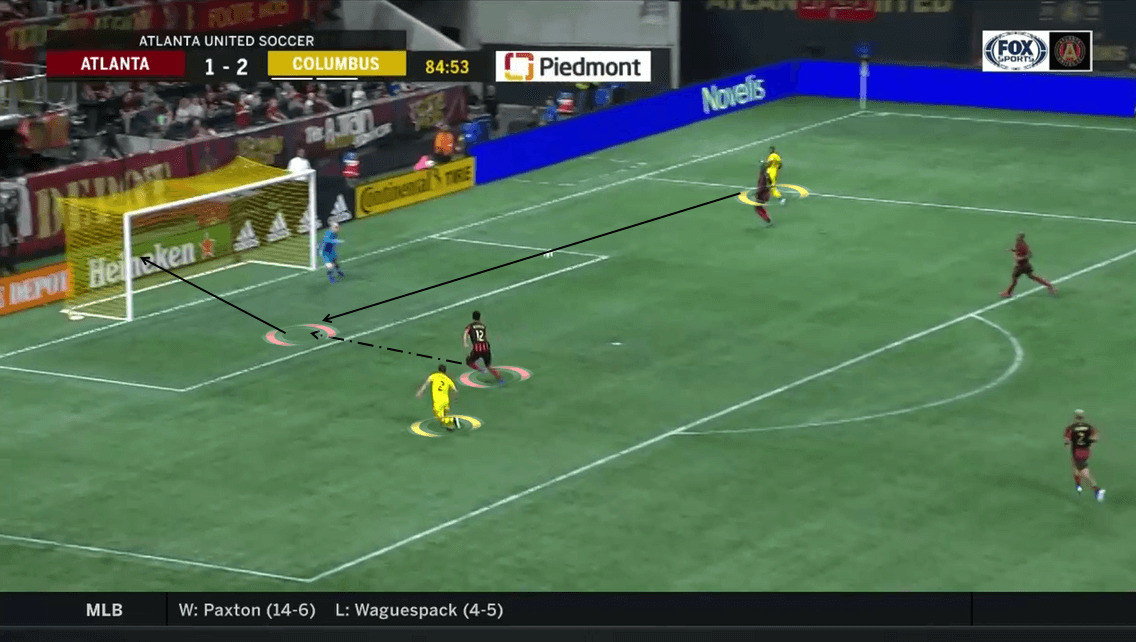
Attacking contributions
Being a part of back-three means that Robinson is also involved in the team’s build-up quite often. During matches where he was deployed as a right-sided centre-back, he and González Piréz usually split wide and occupied both half-spaces, leaving the central area for the central centre-back, which was Parkhurst. They would create a passing triangle near the halfway line and aimed to circulate the ball among each other until they found a teammate who had entered a pocket of space and ready to receive the ball.
In Atlanta’s four-man defence, the build-up principles are kept similar but the two centre-backs will receive support from the single-pivot as he drops in between them to create the passing triangle. Usually that player would be Larentowicz, as the veteran midfielder has the ability to bring the ball out of defence through his direct passes that can help to link the defence with the midfielders, as shown in the shot below against New England Revolution.
As mentioned, with González Piréz being more of a ball-playing defender who tends to make penetrative passes up front, the task of finding that teammate using a long pass is usually put on the former River Plate defender. The ball will be circulated more towards the Argentinian player as he scans for potential receivers up front, then start the attack using a direct pass towards the opposition’s defensive third.
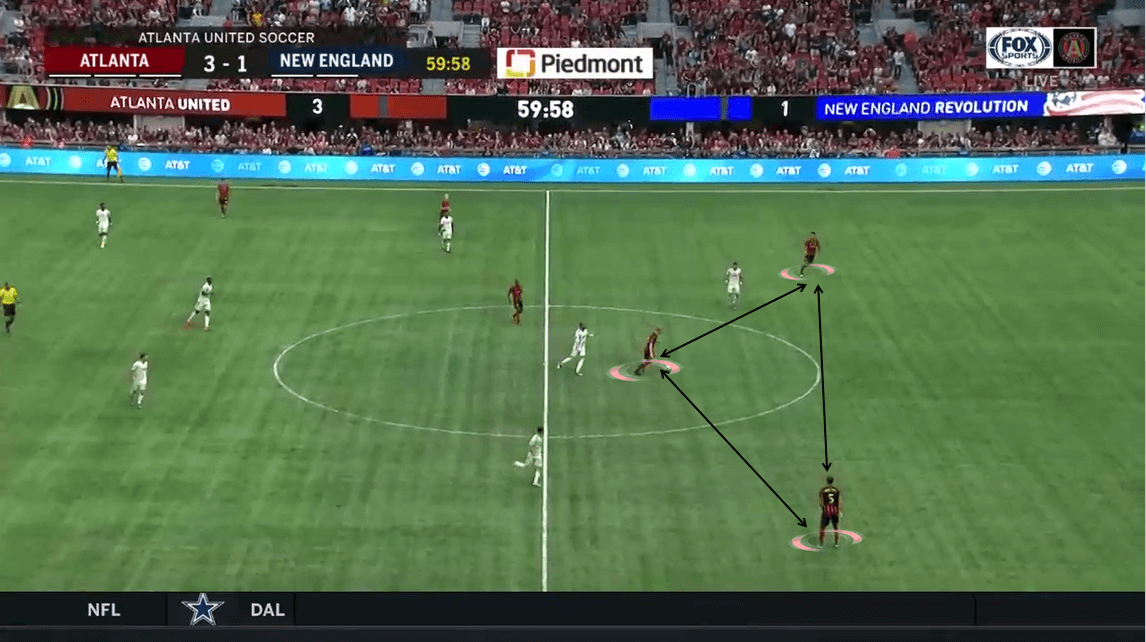
Meanwhile, Robinson is a more conservative passer as he isn’t making too many long passes during the match. The numbers also back this statement as González Piréz registered 9.45 long passes per 90 minutes with the accurate rate of 56.6%, while the American youngster only had 3.5 long balls per 90 minutes and reached the accurate rate of almost 42% – the lowest pair of numbers compared to the other Atlanta’s centre-backs.
Still, he would still make penetrative passes into spaces in between the opposition’s defensive lines whenever he notices a teammate who is ready to receive the ball in that area. Similar to the use of long balls, this will help the team to reduce their build-up time and allow the offensive transitioning process to take place quicker. For a team that tend to put an emphasis on playing the ball quickly, Robinson’s trait benefits Atlanta on many occasions, especially when González Piréz is absent from the match.
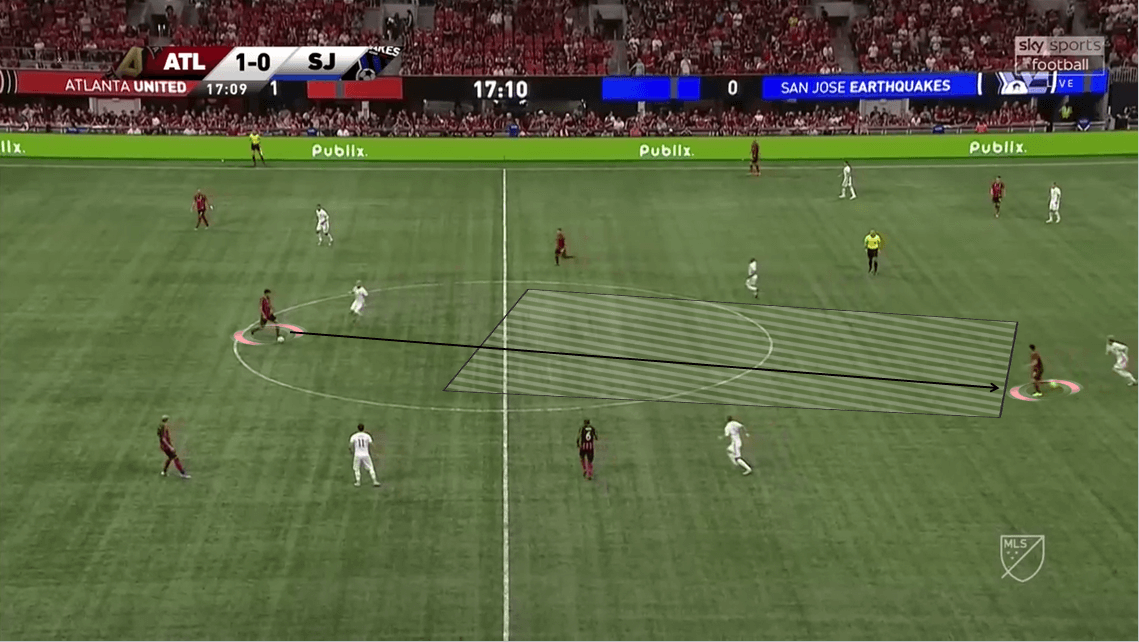
On a few scenarios, we would still be able to see him send direct passes towards the attackers up front, similar to how his Argentinian companion does. Although the accuracy of several of those passes isn’t so high, it shows that he can be involved in the team’s attacking play more often. This is one of the aspects that he is still improving with season after season under the guidance of González Piréz himself to allow him to contribute more to the team’s play and link up with the strikers more often. As he progresses more in the future and if possible, become an American centre-back thriving in Europe, these experiences will be vital for him as he can look back to see what he needs to improve in his long passes.
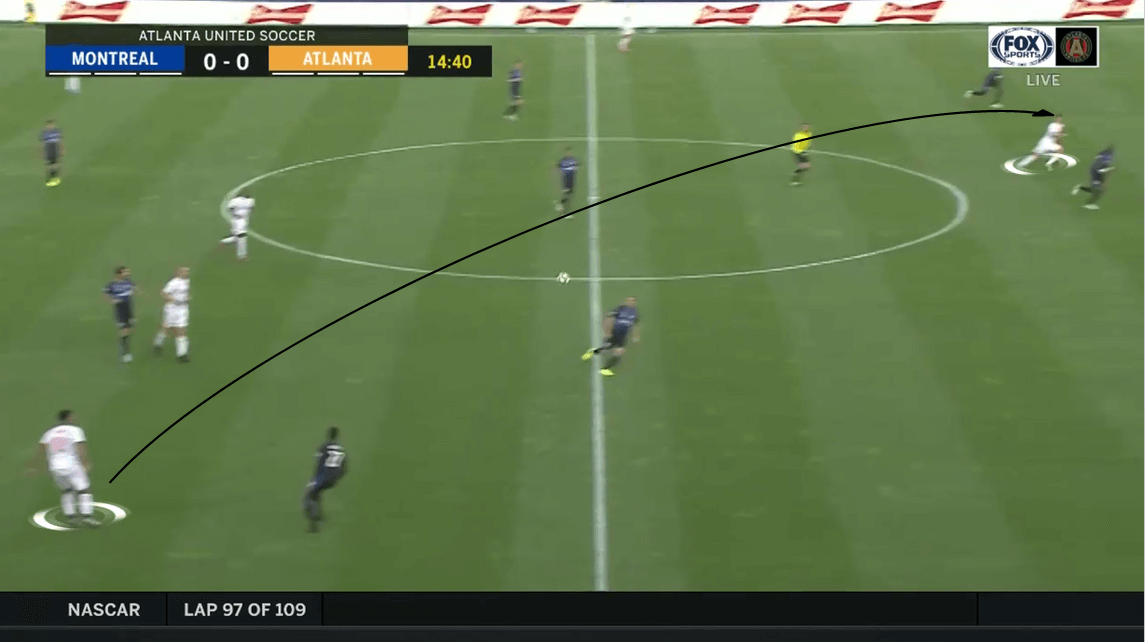
Besides being able to make passes, he can also dribble with the ball by himself. Again looking back at his stats, it is viable to see how he has improved his dribbling ability over the years. In his second season under the guidance of Martino, he only registered 0.23 dribbles per 90 minutes. This season, it rose up to 0.38 dribbles per 90 minutes as he even completed all three dribbles against Montreal Impact.
Amid the fact that the difference between those two numbers isn’t too significant, he did manage to find a way to still be able to contribute to the team’s play this season and cover up his weakness in making long passes. Using his vision and, once again, positional awareness, he can pick out an unoccupied pocket of space and will dribble into it as he continues searching for a teammate to lay the ball towards. For several teams in Europe, they tend to encourage their centre-backs to dribble more on the ball during the team’s offensive transitioning period. Robinson won’t face much trouble adapting to that and even be involved in the team’s build-up when he finds a new challenge outside of America in the near future.
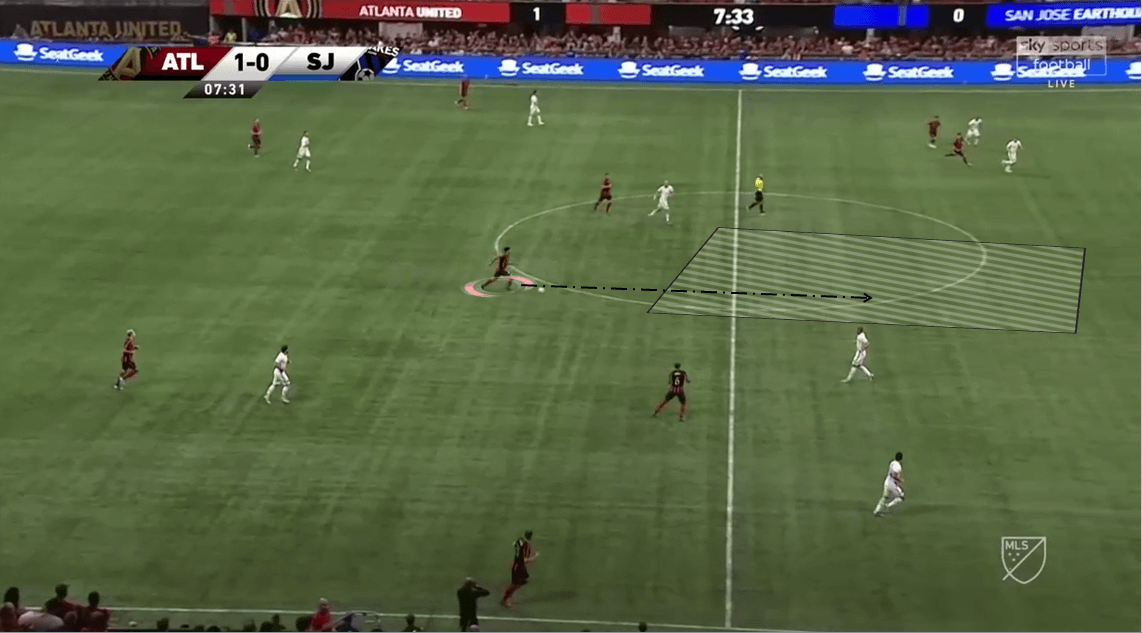
To sum up the article, it is worth looking at his heatmap as this illustrates best the role that he is taking on at Atlanta United. On several occasions, he tends to act as a covering defender who is willing to cover space for teammates that roam from their respective positions. At the same time, he is willing to spend more time inside the box blocking long shots and intercepting passes that are headed towards the area, which is why the density of the heat is being shown inside the box is leaning towards a more yellow tone.
But the area that he can be seen spending time most on the pitch is on the edge of Atlanta’s defensive third and middle third. There, he involves himself in the team’s build-up by creating a passing triangle with his colleagues with the aim of progressing it up the pitch. Also, with the fact that de Boer deploys a high defensive line for Atlanta, Robinson can also feature in more duels in that area as he attempts to tackle the ball away from the ball carrier but not to commit unnecessary fouls for his team.
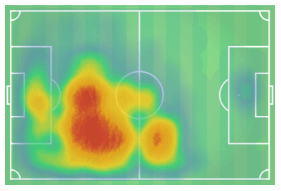
Conclusion
It has been quite fascinating to follow Robinson’s journey to becoming one of Atlanta’s first-choice centre-back and now thriving among the team’s defence. In his early age, he even experienced playing basketball alongside spending time on the soccer field. According to his basketball coach at his high school in a recent interview with the MLS official website, there were traits that he has developed in terms of defending in the role of a point guard.
After being picked second in the 2017 MLS Superdraft by Atlanta, many have expected him to progress more under the guidance of “Tata” Martino. Which he did, eventually, as he became more experienced after returning from a one-season loan at Charleston Battery. Slowly building his place among Atlanta’s defence, he finally received the recognition he deserves with a starting spot and even being named in the MLS Team of the Year this season.
With his current development at the club, the only question that remains among many people is how long until Robinson secures a move to Europe? A work permit is currently the biggest problem as he has just played two matches for the national team, but it won’t be long until he meets the criteria as his recovery from injury is showing some good signs. Nonetheless, next season will be another big season for Robinson himself and Atlanta United as the team have seen many players leave the club and an overhaul transfer window is coming up, with the fans expecting to see players arriving at the club. But no matter what, Robinson will continue to become a solid choice for de Boer’s defensive line along with González Piréz ahead of the club’s fourth season as an MLS franchise.

If you love tactical analysis, then you’ll love the digital magazines from totalfootballanalysis.com – a guaranteed 100+ pages of pure tactical analysis covering topics from the Premier League, Serie A, La Liga, Bundesliga and many, many more. Buy your copy of the November issue for just ₤4.99 here




Comments